
-
 History of Religions
History of the 3 Monotheistic religions (Judaism, Christianity and Islam) and of the main different Christianity confessions (Roman Catholicism, Eastern Catholicism and Eastern Orthodoxy, Anglicanism and Protestantism)
History of Religions
History of the 3 Monotheistic religions (Judaism, Christianity and Islam) and of the main different Christianity confessions (Roman Catholicism, Eastern Catholicism and Eastern Orthodoxy, Anglicanism and Protestantism)
-
 Pedagogical Approaches
New pedagogical approaches to teach history of religion
Pedagogical Approaches
New pedagogical approaches to teach history of religion
-
 Role of Religions in Civilization
How to didactically promote among students of different confessions, the capacity of a critical analysis and understanding of the role played by religions in the history of mankind
Role of Religions in Civilization
How to didactically promote among students of different confessions, the capacity of a critical analysis and understanding of the role played by religions in the history of mankind
-
 Interreligious Students’ Competences
Set of teaching contents, to be used by teachers to highlight and valorize the universal values of tolerance and universalisms that all Monotheistic religions and religious texts contain to promote and sustain mutual understanding among students
Interreligious Students’ Competences
Set of teaching contents, to be used by teachers to highlight and valorize the universal values of tolerance and universalisms that all Monotheistic religions and religious texts contain to promote and sustain mutual understanding among students
-
 Managing Multi-Religious Classes
Teaching Sources to help teachers dealing with multicultural and multi-religious classes
Managing Multi-Religious Classes
Teaching Sources to help teachers dealing with multicultural and multi-religious classes
-
 Introduction
A comparative review of the liturgical celebrations, ceremonies and dietary rules existing in the different religions.
Introduction
A comparative review of the liturgical celebrations, ceremonies and dietary rules existing in the different religions.
-
 Celebrations
Description and comparative analysis of the celebrations of different religions and confessions
Celebrations
Description and comparative analysis of the celebrations of different religions and confessions
-
 Ceremonies
Description and comparative analysis of the ceremonies of different religions and confessions
Ceremonies
Description and comparative analysis of the ceremonies of different religions and confessions
-
 Dietary Rules
Description and comparative analysis of the dietary rules of different religions and confessions
Dietary Rules
Description and comparative analysis of the dietary rules of different religions and confessions
Events
The Pathway through Religions project has been promoted trough conferences and articles.
Partnership
-
 Contractual Partners
From this section it is possible to access to a description of each contractual partner of the Pathway through Religions project.
Contractual Partners
From this section it is possible to access to a description of each contractual partner of the Pathway through Religions project.
-
 Schools
From this section it is possible to access to the information about the schools involved in the Pathway through Religions Project in the European countries involved.
Schools
From this section it is possible to access to the information about the schools involved in the Pathway through Religions Project in the European countries involved.
-
 Associated Partners
As a result of the exploitation activity a number of associated partners officially joined the project in order to contribute to the improvement of the project impact on their target groups and to ensure the project sustainability by continuing using the project deliverables in the next years.
Associated Partners
As a result of the exploitation activity a number of associated partners officially joined the project in order to contribute to the improvement of the project impact on their target groups and to ensure the project sustainability by continuing using the project deliverables in the next years.
This section of the Pathway through Religions portal provides administrative information for the project contractual partners and for the European Commission and it is password protected.
Celebrations
Homepage > Training Course > Celebrations

Description and comparative analysis of the celebrations of different religions and confessions
Celebrations
The name "Pentecost" comes from the Greek word Πεντηκοστή (Pentēkostē) meaning "fiftieth". The reason is that Pentecost is the fiftieth day after Easter.
This name came into use in the late Old Testament period and was inherited by the authors of the New Testament. The Jewish feast of Pentecost, known as Shavu`ot (Hebrew, "weeks"), was primarily a thanksgiving for the firstfruits of the wheat harvest, but it was later associated with a remembrance of the Law given by God to Moses on Mount Sinai.
In the early church, Christians often referred to the entire 50-day period beginning with Easter as Pentecost. Baptism was administered both at the beginning (Easter) and end (the day of Pentecost) of the Paschal season. Eventually, Pentecost became a more popular time for baptism than Easter in northern Europe, and in England the feast was commonly called White Sunday (Whitsunday) for the special white garments worn by the newly baptized. In The First Prayer Book of Edward VI (1549), the feast was officially called Whitsunday, and this name has continued in Anglican churches. In Catholic and other Western churches, priests often wear red vestments during Pentecost to symbolize the “tongues of fire” that descended on the disciples from the Holy Spirit.
The Pentecost represents the fulfillment of Christ's promise from the end of Luke's Gospel: «Thus it is written, that the Christ should suffer and on the third day rise from the dead, and that repentance and forgiveness of sins should be preached in his name to all nations, beginning from Jerusalem. You are witnesses of these things. And behold, I send the promise of my Father upon you; but stay in the city, until you are clothed with power from on high» [Luke 24]. This "clothing with power" comes with the bestowal of the Holy Spirit upon the Church.
The symbols of the Holy Spirit are the elements of wind and fire. Wind is a basic symbol of the Holy Spirit, as the Greek word for "Spirit" (πνεῦμα) also means "wind" and "breath."
This Solemnity makes us remember and relive the outpouring of the Holy Spirit on the Apostles and the other disciples gathered in prayer with the Virgin Mary in the Upper Room (cf. Acts 2:1-11). Jesus, risen and ascended into Heaven, sent his Spirit to the Church so that every Christian might participate in his own divine life and become his valid witness in the world. The Holy Spirit, breaking into history, defeats aridity, opens hearts to hope, stimulates and fosters in us an interior maturity in our relationship with God and with our neighbors.
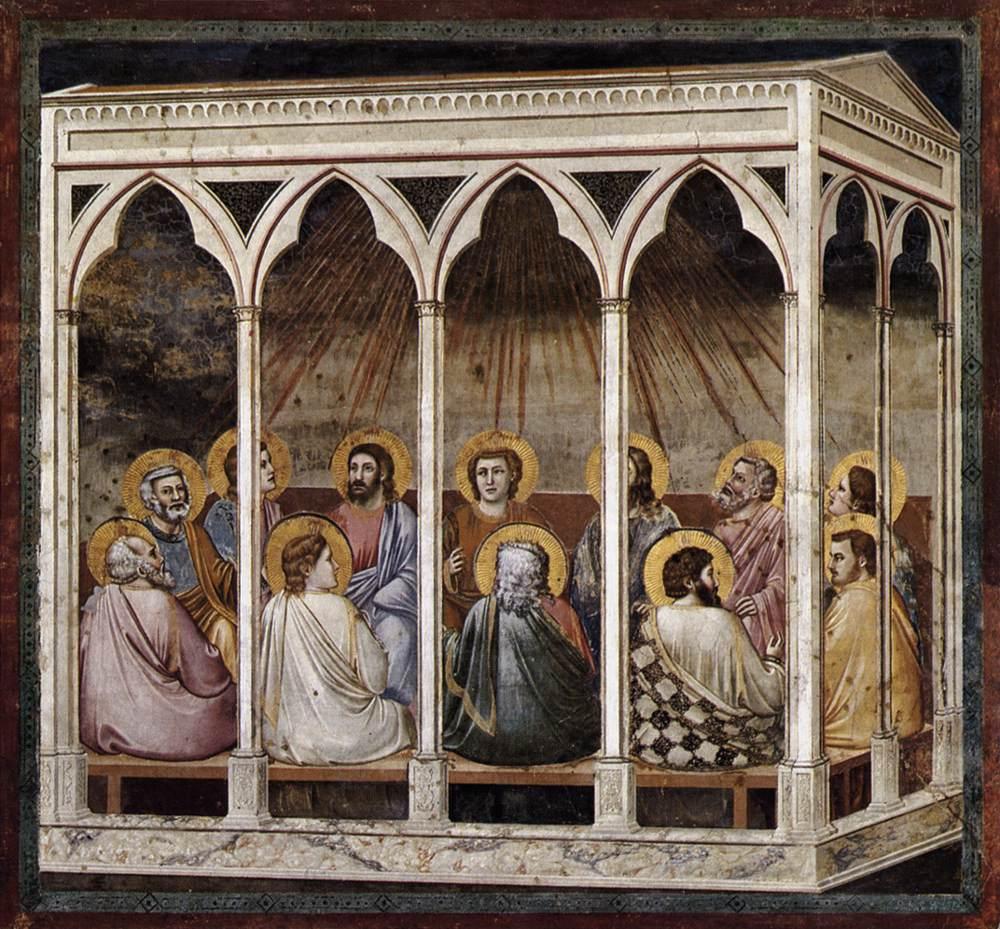
Giotto, Pentecost, 1303-1305, the Scrovegni Chapel, Padua. Pentecost is the last of the Stories of the Passion of Jesus frescoed in the Scrovegni Chapel. Pentecost is being celebrated in a structure set obliquely in space, and whose Gothic arcades permit a view of the interior. The disciples have gathered, and rays from the Holy Ghost descend upon them. Their faces show astonishment and transfiguration. It is worth noting that the setting of the Pentecost is very nearly the only one at Padua that directly reflects contemporary Gothic architecture.
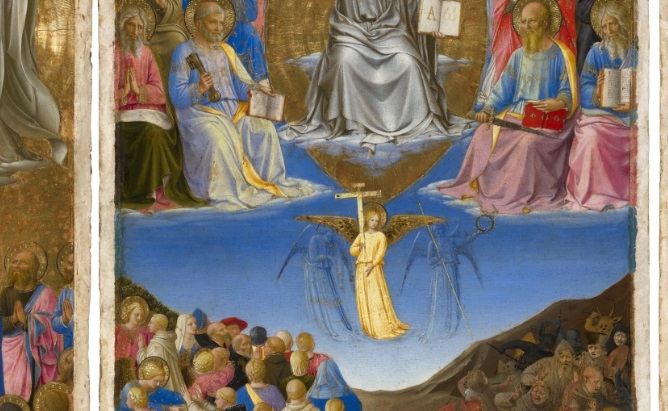
Beato Angelico, Triptych of the Last Judgment, Ascension and Pentecost, 1450-1455, Corsini National Gallery, Rome. Inside the triptych, the side panel on the right is dedicated to Pentecost. Remarkable is the scrocio of the dove that is turned upside down on the disciples, because it coincides with the vanishing point corresponding to the mullioned window above, behind the dove itself. In this painting Beato Angelico lets the mystery of the action of the Holy Spirit emerge in the world that with his strength (δύναμις) acts in the life of man in a powerful way, but also discreet and silent.
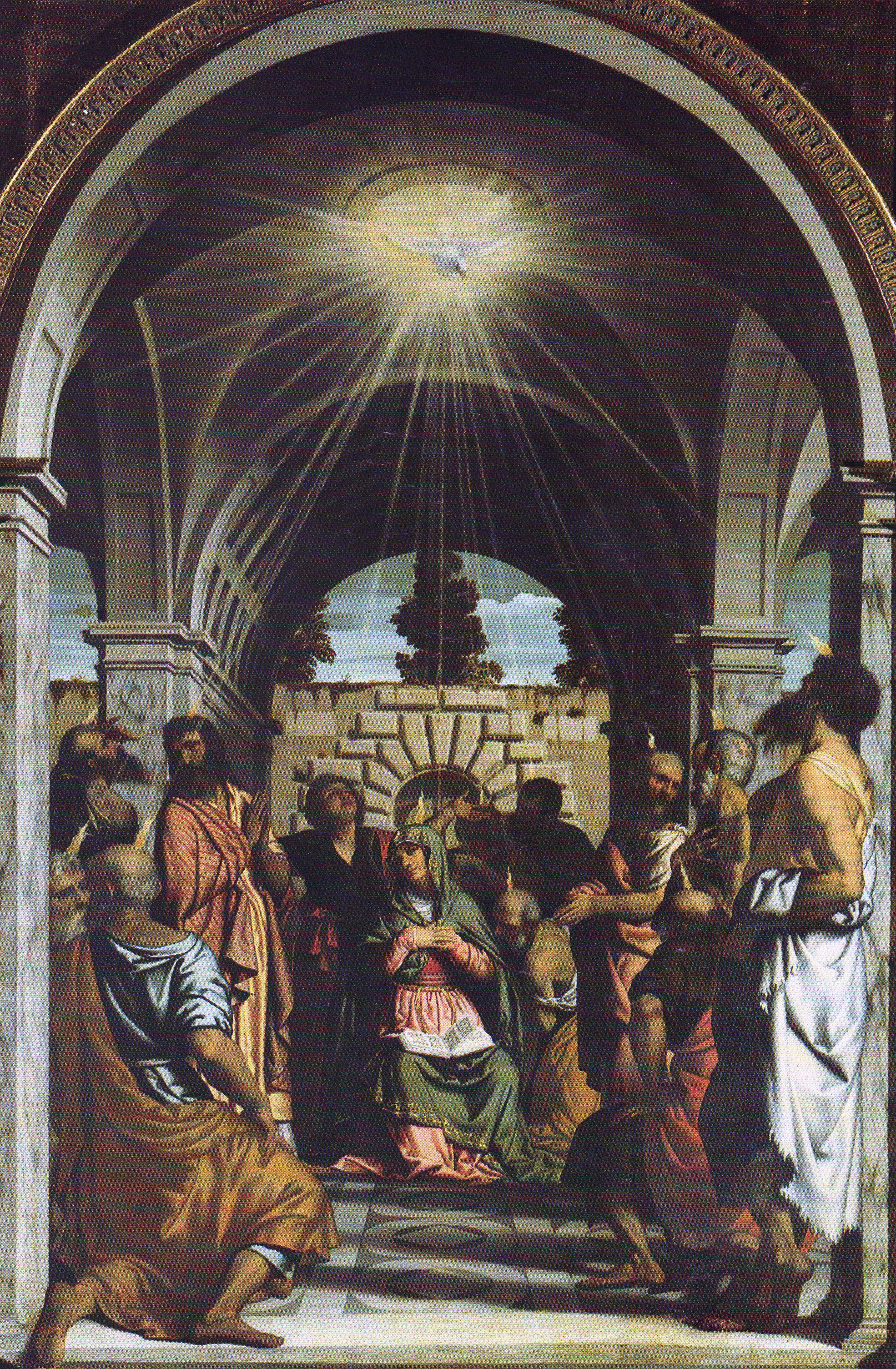
Alessandro Bonvicino, called Moretto, Pentecost, 1543-1544, Tosio Martinengo Art Gallery, Brescia. According to the canonical system, in the center is the Madonna surrounded by the Apostles, all those struck in the forehead by the rays coming from the Holy Spirit who, in the form of a dove, stands out on the upper part of the canvas. The scene takes place in an environment covered by a cross vault and open on all four sides.
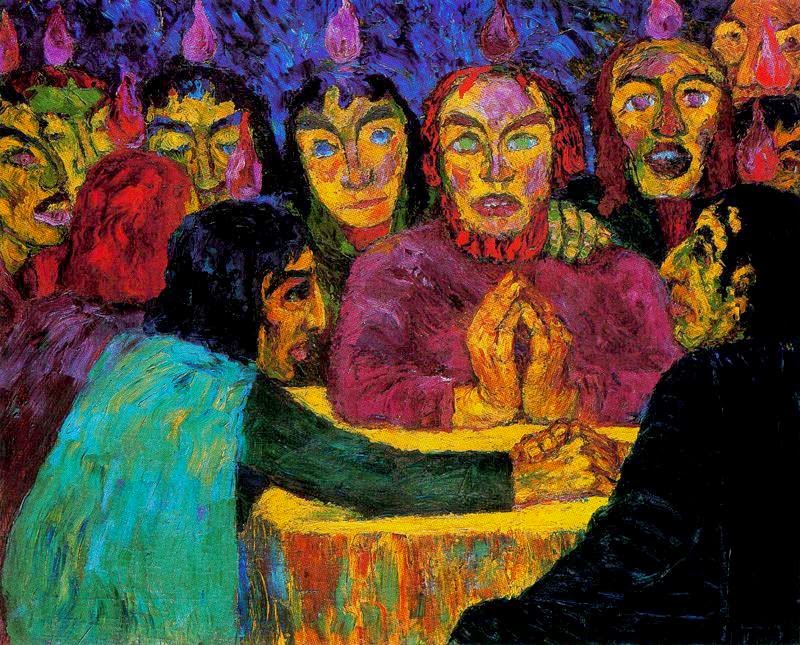
Emil Nolde, The Pentecost, 1909, Nationalgalerie, Berlin. Nolde devoted 55 paintings to sacred themes from 1909 to 1951, thus bearing witness to his religious convictions, although in practice they were very personal. In this picture, while all have a tongue of fire on their heads, various faces express resignation, shock, exuberance, quiet prayer, and downright terror. It beautifully depicts a wide range of responses to the descent of the Spirit. So too, the life of faith admits of a variety of doubts, struggles, and challenges.
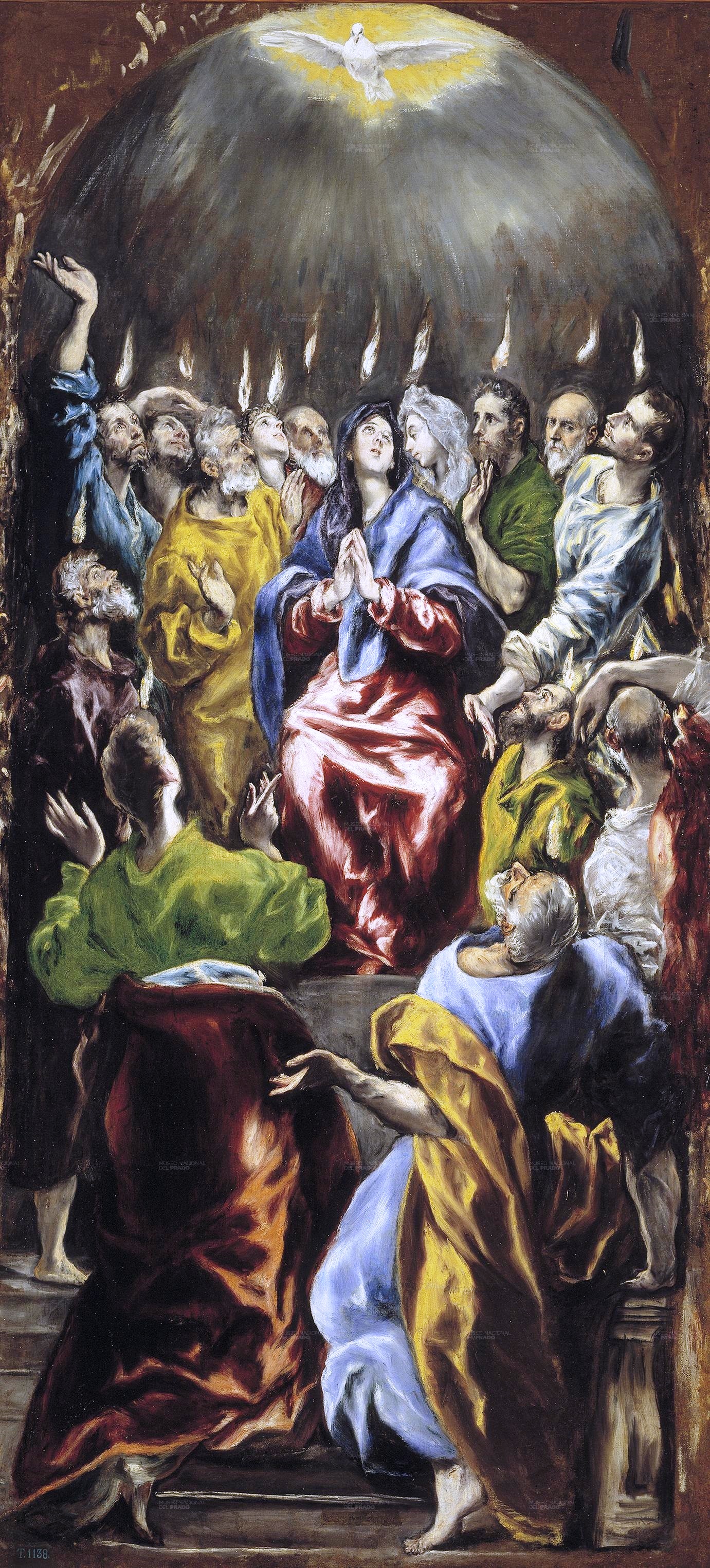
Doménikos Theotokópoulos most widely known as El Greco, The Pentecost, 1597-1600, Prado Museum, Madrid. El Greco made this painting as part of an altarpiece for the church of the monastery Lady Mary of Aragon in Madrid. The altarpiece also included an Annunciation, Baptism, Crucifixion and Resurrection. The flames of the Holy Ghost descend on Mary, the apostles and some woman. The bald, bearded Apostle who looks out at the viewer from the right of the canvas has been identified as a self-portrait, or as a portrait of the artist´s friend, Antonio de Covarrubias.
What is Pentecost? From the Greek meaning “fifty,” the festival of Pentecost celebrates the coming of the Holy Spirit to the apostles on the fiftieth day after Easter. On this day, we worship the Lord, who gives life to His Church, by decorating the church in red and by focusing on the work of the Holy Spirit.


